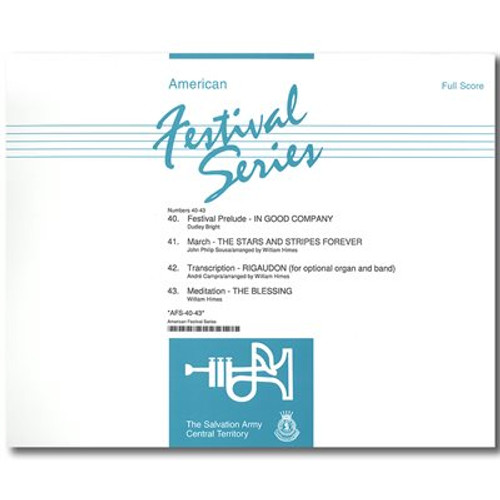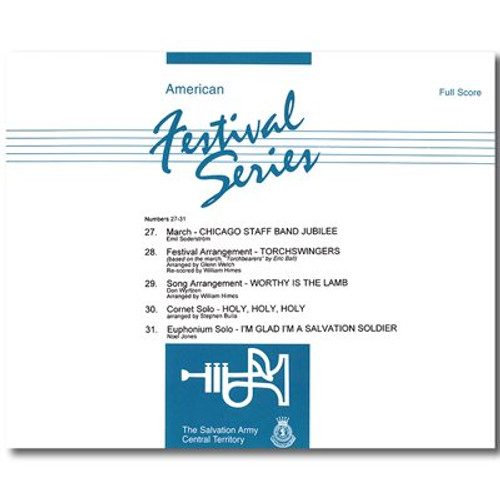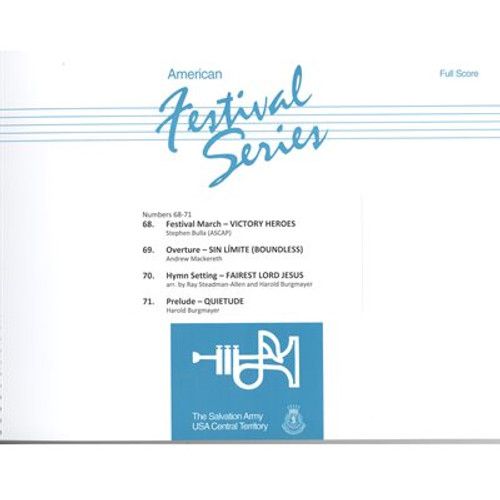Product Description
December 2003 Nos. 32-34
Comments by
Staff Bandmaster William Himes
Music & Gospel Arts Secretary, USA Central Territory
| 32. | Selection - Emblems | James Curnow | Notes |
| 33. | Selection - Endless Praise | William Himes | Notes |
| 34. | Song Arrangement - In His Presence | Dick and Melodie Tunney, arr. William Gordon | Notes |
Produced by The Salvation Army - Central Territory
32. Selection - Emblems
Program Note:
The Salvation Army has many symbols that represent its commitment to God and its mission to humanity. The composer portrays some of these symbols and foundations of faith through the use of melodic fragments of familiar themes including "Amazing Grace," "Nothing but the blood," "We'll never let the old flag fall" and "Army of God." Two songs are features in their entirety to represent two cornerstones on which this movement was founded: "Near the Cross" and "Lift up the banner."
The Salvation Army has many symbols that represent its commitment to God and its mission to humanity. The composer portrays some of these symbols and foundations of faith through the use of melodic fragments of familiar themes including "Amazing Grace," "Nothing but the blood," "We'll never let the old flag fall" and "Army of God." Two songs are features in their entirety to represent two cornerstones on which this movement was founded: "Near the Cross" and "Lift up the banner."
Note to the Conductor:
If one were to sum up in a word the interpretive approach to this selection it would be passionate. After all, this is more than music for The Salvation Army, it is music about our movement. The many moods portrayed - majestic, contemplative, playful, fierce - should be under girded with an intensity befitting the Army's rich heritage of ministry and worldwide mission.
Any technical demands will be quickly apparent and accessible, with most challenging motifs reserved for soloists rather than sections. (An exception would be bars 115-126 in which the trombone section will have its work cut out for it in terms of balance, intonation and execution.) Although there are frequent shifts between symmetrical and asymmetrical meters (see bars 37-57), most bands are quite familiar with this rhythmic technique these days. Nevertheless, some care (and math!) will be needed for hte cross rhythms called for in the cornet and trombone parts here.
Bands should find this music to be interesting to learn with a meaningful message for listeners. As evocative as this music was originally conceived, it would be al the more enhanced with creative video reinforcement highlighting the symbols of the cross, the crest and the flag.
33. Selection - Endless Praise
Program Note:
This cheerful colleciton of three well-loved hymns, "My Savior's Love," "Blessed Assurance," and "Joyful, joyful we adore thee" is reflective of the spirit and character of two friends for whom this was especially written: Commissioners Raymond and Merlyn Cooper, former leaders of The Salvation Army's Southern Territory, based in Atlanta.
This cheerful colleciton of three well-loved hymns, "My Savior's Love," "Blessed Assurance," and "Joyful, joyful we adore thee" is reflective of the spirit and character of two friends for whom this was especially written: Commissioners Raymond and Merlyn Cooper, former leaders of The Salvation Army's Southern Territory, based in Atlanta.
Note to the Conductor:
This selection, written in overture style, features three well-worn hymns and presents each with an unconventional twist. There should be plenty here to keep the band busy with music intended to connect with the audience. Attention to the following areas should assure an effective performance:
Introduction: The driving rhythmic motif in basses and timpani should be clear and energetic, yet light on the tongue. This is contrasted by a bold "Battle cry" in the cornet section beginning at bar 9. Strive for confidence with accuracy in this unison trumpet call.
Bars 19-55: The mood is bright; the style should be bouncy.
Bars 56-67: Making an effective transition here is key to the success of the following section. While the music doesn't appear to be difficult, experience has shown this to be a treacherous patch indeed! To pull this off, keep the following in mind:
The rallentando in bars 56-57 is controlled primarily by the basses. At bar 58 the tempo should be steady and unhurried, with careful balance of accompanying horns and baritones so the cornet, euphonium and flugel entrances can be heard without difficulty.
Bars 61-67 features a trio (soprano, solo cornet and 1st trombone) presenting a transparent, ethereal motif, emphasizing the text "I stand amazed in the presence." It is vital that the conductor take the opportunity at bar 67 to establish the new tempo that will be revealed by the basses and percussion in the succeeding bars.
Bars 67-151: The success of this samba section will largely depend on the effectiveness of hte percussion section as well as the articulation style of the band to be effective. Considerable effort has been made to provide clear articulation markings here. Conductors will want to distinguish between the usual accent, tenuto, staccato and martellato (^) markings. The latter is achieved with the tongue starting and stopping the note with the syllable "doot."
The main this is to strive for a relaxed sound and style with careful attention to the balance of the jazz harmonies in abundance here.
Bars 148-151: Again, the percussion and basses control this gradual ritardando with a sultry conclusion from the cornets. Following the pause on the first two beats of bar 151 the conductor should cue the timpani on beat 3 in the allegro tempo of the final section.
Bars 167-174: The unison unaccompanied melody in 1st and 2nd cornets and flugel should be sustained yet well marked.
Bars 187-221: Here the familiar "Ode to Joy" (Europe) is twisted around a bit with this 3/4 setting. In spite of the frequent syncopation the approach should be light and cheerful. In contrast to the theme, the occasional trio entries from solo cornet and soprano should be timely and suave.
Bars 245-248: The accelerando should be just enough to reach a comfortable alla breve tempo at 249. The opening rhythmic motif returns here (cornets, percussion) as an ostinato over the rest of the band, playing the theme in a warm, sonorous style.
Bars 265-end: The conductor should strive for three things here: First, a careful but brilliant balancing of cornet and trombone harmonies at bars 269-270 and 273-274. Secondly, a controlled accelerando at bars 271-277 so as to avoid getting too fast, too soon. Finally, the 3/4 bars 281-286 will require careful attention to the opposing cross-rhythms and syncopations in order for the music to reach an unwavering and exciting finish.
34. Song Arrangement - In His Presence
Program Note:
A tranquil, contemplative orchestration, reflection the theme of the lyrics of this popular worship chorus:
A tranquil, contemplative orchestration, reflection the theme of the lyrics of this popular worship chorus:
- In His presence there is comfort;
- In His presence there is peace.
- When we seek the father's heart
- We will find such blessed assurance
- In the presence of the Lord.
Note to the Conductor:
Bands should find this expressive setting to be equally useful in worship and festival settings. While the music is not technically demanding, it will require all the sensitivity and tone that a band can muster to maximize its potential. The composer has provided and abundance of expression markings which should help achieve a performance that is expressive without being overly sentimental, allowing the music to speak for itself.







